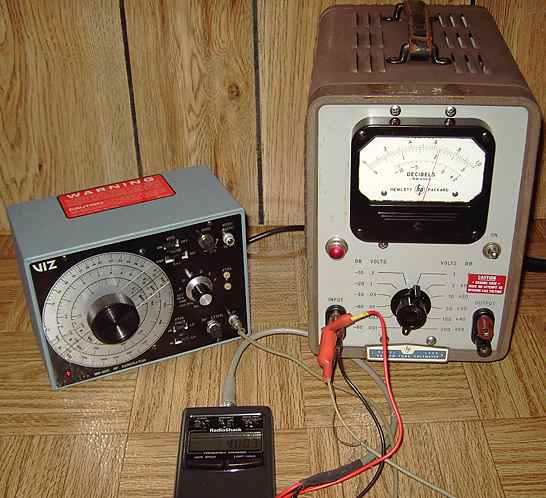needed for a stable frequency counter reading at 4 MHz (about 0.65 millivolt)

OK. I admit to repairing some items simply to satisfy my curiosity about the circuit and the function of the device. The HP-400D is one such piece.
The HP-400D Vacuum Tube Volt Meter is a wide-band RMS voltmeter and amplifier. It is capable of reading AC from 1 millivolt full scale to 300 volts full scale. It has wideband response from below 10 hertz to a specified working accuracy limit of 4 Megahertz. As an amplifier, it has a cathode follower output for monitoring, regardless of input switch setting, at about 0.15 volts at 50 ohms impedance.
I purchased a pair of HP-400D VTVMs at an auction. Neither one was working properly. I had never worked with one of these before so I decided to see what made it tick and what uses these could have in the shop. A military manual in PDF form is available from the BAMA site. The schematic is on page 39 of that manual. Essentially the meter consists of a cathode follower input stage, a highly accurate switch selected resistive divider for that input stage, and four additional stages of amplification. The amplifier uses five 6CB6 pentodes, some or all of which may have been replaced with plug in "fetrons" (direct plug-in Field Effect Transistor substitutes for the 6CB6). The final amplification stage feeds a pair of diodes for full wave rectification to a meter and a pair of capacitors completing a bridge and supplying negative feedback to the amplifier for wide band response. Four additional tubes supply regulated B+ voltage to the amp sections. Those are a 6AX5 rectifier, a 12B4A pass tube, a 6U8 control tube, and a 5651 voltage regulator. An earlier variation uses a 6AV5 for pass tube, a 6CB6 as control tube, and an 0A2 regulator.

Repairs
This is my first time with servicing and playing with an HP-400D VTVM. Let me know if you have serviced these more often and have some hints, shortcuts and "gotchas" to look out for. The symptoms on my examples were erratic meter movement, inability to zero, and low sensitivity (such as low readings when connected to a known 6.3 VAC source). One of the two examples had had all of the 6CB6 tubes replaced with Fetrons. I decided to repair one of the two and to possibly use the other for parts or for its voltage-regulated power supply.
There is no electronic zeroing control on these meters. I isolated the final amp stage (V5) by pulling the tube feeding it (V4) leaving just V5 in the circuit to the meter. The inability-to-zero problem turned out to be the two large capacitors that form the meter bridge. They were both leaky. Replacing them helped to solve the problem. Pulling the tubes one at a time in the chain helped to further isolate problems in the previous stages. I tested the 6CB6 tubes and found all of them to be somewhat weak according to my stingy military TV-7 tube tester. That would explain low meter sensitivity. I also tested the Fetrons by using the same 6CB6 settings. I don't know if that is a recommended procedure. All of the Fetrons showed high transconductance, testing as if they were new 6CB6 tubes or better. In the tube tester, all of the fetrons will show some normal "leakage" between the filament pins and the cathode pin when tested as a 6CB6. One of the five fetrons was initially a bit unstable.
I ended up putting all of the fetrons into the 400D example that showed the most promise. It was still a bit unstable and it read high, even when the meter calibration potentiometer (R-107) was turned all the way down. I determined that the fetrons might have been TOO high in transconductance making the meter amp a bit too sensitive. I plugged a 6CB6 tube into the final stage (V5) and then also determined which of the fetrons was causing instability. I removed that fetron. With one 6CB6 (V5) and four fetrons (V1 though V4), the meter could be adjusted to read accurately and was stable.Note that V5 has a regular 6.3 volt AC filament source but that the filaments for V1 through V4 are fed by a DC source in a series-parallel arrangement. If tubes and fetrons are mixed in V1 - V4, care must be taken to assure that the tubes have appropriate filament voltage.
"Playing" with an HP-400D
I hooked up my signal generator to the HP-400D and noted that I could read the output level. It seemed to be fairly stable to about 5.5 megahertz and then dropped off sensitivity rapidly. The meter is accurate to a specification of 5% full scale at 4 megahertz. It should do fine for reading the voltage level on a 50 ohm dummy load on 80 meters.
The amp output can be monitored by a scope or by headphones if the signal is audio and will even drive a speaker to a low level. Its output is matched at 50 ohms.
An amp and meter than is relatively flat from 10 Hz all the way through the 80 meter ham band (4 MHz) can also be used for some interesting experiments. Let me know how you have used yours.
A Navy REP receiver made by Crosley was the previous item on the bench.